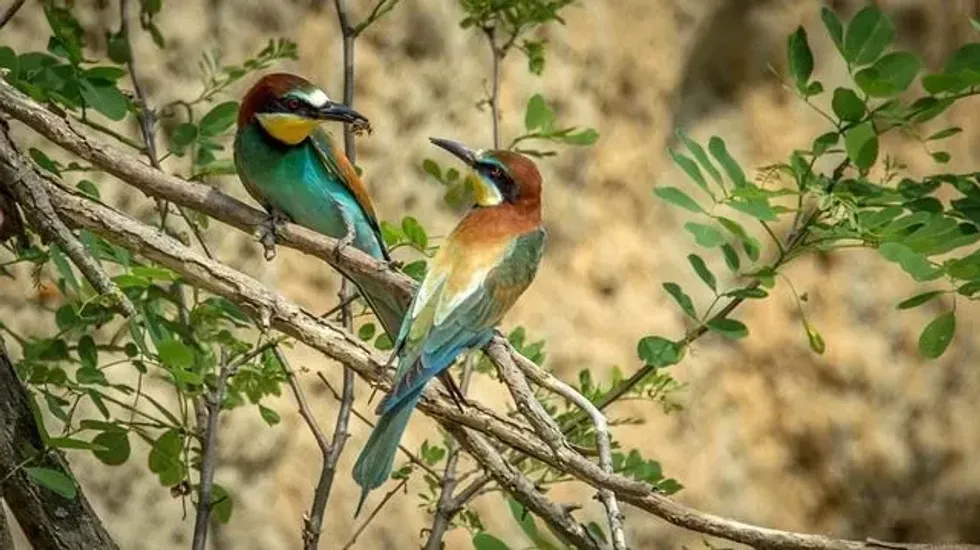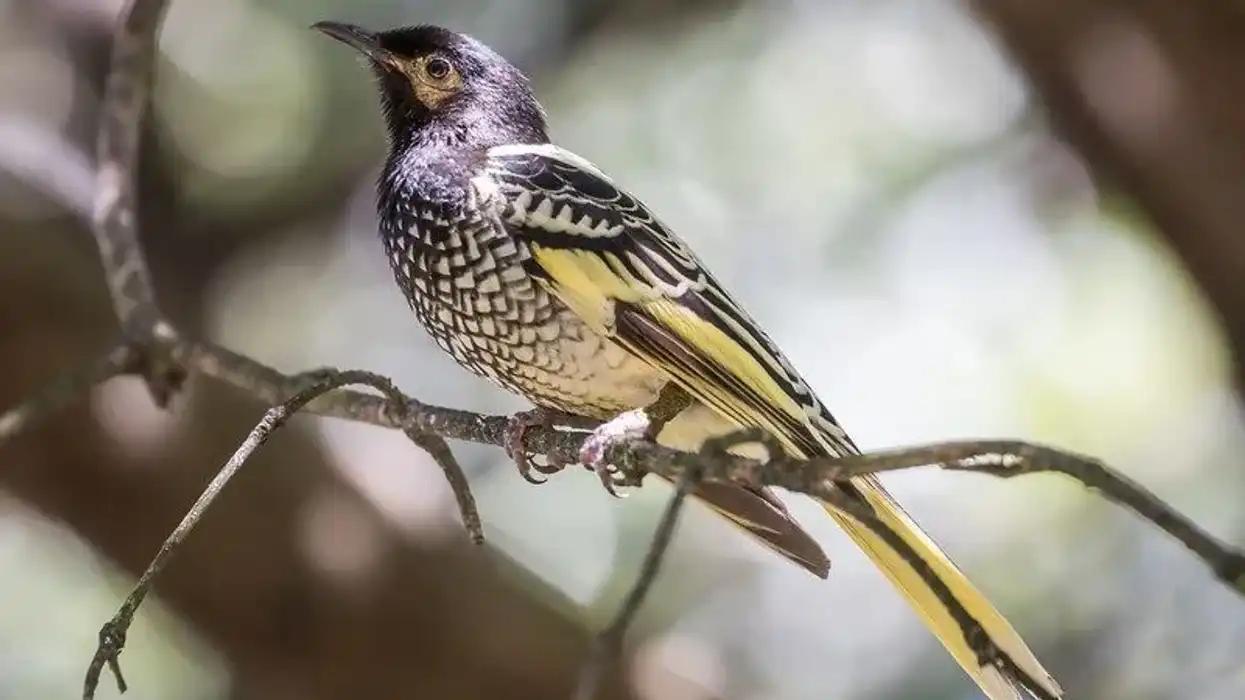As the name suggests, Bee Eaters prey on flying insects like bees, wasps, and hornets. They also eat ants and are found in Africa, Asia, Europe, and Australia. Some of these bird species are even named after the country of their origin. For example, the European Bee-Eaters (Bee-Eater Merops Apiaster) belong to Europe.
They are stunningly beautiful, bright-colored, active, and social birds. Some Bee Eaters have elongated central tail feathers to cover long-distance journeys. This bird species is super fast and vicious when it comes to grabbing their food. They sit and wait on their perch for the prey.
They eat flying insects and bees. These birds fearlessly pick bees and flying insects out of nowhere with their curved beak, hitting and rubbing the insects repeatedly on a hard surface. This removes all the poisons before eating them.
Explore the fun and amazing Bee Eater bird facts. Also, read about birds of paradise and song thrush facts.
Bee-Eater Interesting Facts
What type of animal is a Bee-Eater?
The Bee Eaters are diurnal birds. The Bee Eaters may migrate during the day and stop at night, especially when crossing a sea or a rough terrain.
What class of animal does a Bee-Eater belong to?
They belong to the class Aves and family Meropidae.
How many Bee-Eaters are there in the world?
The exact number is unknown since around three genus and 25 species of Bee Eaters are widely distributed worldwide.
Where does a Bee-Eater live?
The Bee Eaters are found in Europe, Australia, Asia, and Africa. They live in the wooded savanna, grasslands, sandy banks near the rivers, and sandy cliffs. Since they are migratory birds, they move from one place to another during the breeding season.
What is a Bee-Eater's habitat?
The Bee Eaters are found in subtropical, temperate, and equatorial rainforests. They build burrows like tunnels in sandy cliffs. They live in large colonies of 100-200 birds, and their nesting is located near one another. The nest holes are in the shape of tunnels so that the eggs they lay are safe from the predator's eye.
The Blue-Headed Bee Eaters prefer to live in the rainforest. It builds its nest near the ground in the gaps between the trees where light does not reach. Six other species prefer the rainforest, but they build their nest near the sandy banks of the rivers.
The European Bee-Eaters chose Southern Europe for breeding, and its habitat comprises Western and Southern Africa during the winters.
The White-Throated Bee Eaters are found nesting in the sub-desert Steppe at the southern end of the Sahara desert during the breeding season. In the non-breeding season, they prefer to live in the equatorial rainforest of Central and West Africa.
Who do Bee-Eaters live with?
The Bee Eaters live in packs. They have complex social behavior. Most of the birds of some species live in large colonies.
These colonies may contain 50-200 burrows like tunnels, depending on the clan size. The male and female of the Red-Throated and the White-Throated are found to live in pairs. The male is the helper of the female and her offspring.
How long does a Bee-Eater live?
The Bee-Eaters have a lifespan of five to six years.
How do they reproduce?
The Bee Eaters are generally monogamous, i.e. they are found to mate with only one male. The male and female breeding pairs are found to build their nest together. The nesting comprises a long tunnel-like burrow 3 ft (1 m) in the sandy cliffs.
The female lays around two to nine eggs. The eggs are white in color and spherical in shape. Often the females are found to lay eggs, keeping a gap of two days.
Finally, the eggs are incubated for a 19-21 days period. Depending on the type of species, the clutch size varies. Both the male and female are responsible for raising their chicks.
The European Bee-Eaters (Bee-Eater Merops apiaster) and Blue-Cheeked Bee Eaters are also found to have the most success rate inbreeding.
What is their conservation status?
The conservation status of the Bee Eaters is the Least Concern category. According to the IUCN, they are a species that are not threatened or vulnerable, or critically endangered. They are not rare nor facing huge threats.
Bee-Eater Fun Facts
What do Bee-Eaters look like?
The Bee Eaters are non-passerine, beautiful and bright-colored, medium-size birds. Their vibrant colors are sure to grab your attention. The males and females look the same. Their body color comprises red, blue, yellow, purple, green, white, black, cinnamon, olive, and rainbow. The beak is long, curved, and pointed. They have sharp claws, which help get hold of a perch and dig burrows for nesting. This bird species with migratory habits has elongated central tail feathers. Those species covering short-distance flights have short and round wings.
How cute are they?
They are super cute, attractive, and brightly colored birds. For example, the European Bee-Eater (Bee-Eater Merops apiaster) has a blue and rusty body with a brightly colored yellow throat. The White-Fronted Bee-Eater has a beautiful white forehead and red throat. Its upper body is covered with green feathers and the underparts in cinnamon.
How do they communicate?
The Bee-Eater species make soft sounds. During the breeding season, the males display courtship by calling and raising their throats and showing their winged feathers.
The White-Throated Bee-Eater breeding pairs perform the butterfly style, settle somewhere facing each other, raise and fold their wings, and start calling for mating. The Little Green Bee-Eaters, Merops orientalis make a soft chirping sound and short calls to alarm their group.
How big is a bee-eater?
The bee-eaters are medium-sized birds. The average height and length are around 8.5-9.5 in (21.6-24 cm). The bee-eaters are two times smaller than the Pied Kingfishers.
How fast can a bee-eater fly?
The bee-eater bird species are expected to fly twice as fast when flapping and gliding their wings. They fly very swiftly and fast to catch insects. The European bee-eaters can spot wasps within 330 ft (60 m).
How much does a bee-eater weigh?
A male bee-eater's weight is around 0.1-1.3 oz (3-37 g) and a female bee-eater weighs 1.1-1.2 oz (31-34 g).
What are their male and female names of the species?
The male bee-eater bird is known as a 'cock', and the female bee-eater bird is known as a 'hen'.
What would you call a baby bee-eater?
The baby bee-eater is called a 'chick'.
What do they eat?
The bee-eaters feed on flying insects, bees, wasps, and hornets. They have special skills to spot their prey from a distance.
They hit and rub the insect on a hard surface and remove the toxins present with their sharp beak. In some species like the European bee-eater, courtship feeding is observed. The males get the food for the females of their choice.
Are they dangerous?
No, they are not dangerous.
Would they make a good pet?
Yes, they would make a good pet. Since bee-eaters are harmless to humans, you can keep them in a cage so that they do not fly away. They are medium-sized birds, so do keep in mind protecting them from predators like large birds, hawks, snakes, dogs, cats, and others.
Did you know...
'Merops' is an Ancient Greek word for 'Bee-Eater.'
The bee-eater bird species can eat 250 bees in a day. This bird species remove the poisonous stings before consuming its prey. This is why it thrashes its prey and breaks its exoskeleton.
Owls prey on birds; this means they eat bee eaters.
The social behavior of the bee eater is described as complex. Many birds of this species live in large colonies of 100-200 birds and perform cooperative breeding.
Most interestingly, some of these bird species have an extended family and recognize their parents, offspring, sibling, their clans, nesting neighbors, and friends through the voice.
The bee-eater's migration process
Many bee-eater species migrate to other regions for mating and to escape the winter.
The European bee-eater facts about migration include that they migrate for breeding and escape the harsh cold season. During the breeding season, the European bee-eater lives in southern Europe, and during the winters, they migrate to southern and western Africa.
The Carmine bee-eater facts about migration show us that they perform three-stage migration. They breed in Mozambique and Angola, then migrate to South Africa, Botswana, and Namibia. During the winter, they live in Tanzania, Angola, and Congo.
The green bee-eater facts about migration reveal that the green bee eaters do not migrate, but they make seasonal movements during the rainy season.
The rainbow bee-eater breeds in southern Australia and migrates to northern Australia, Indonesia, and New Guinea during the winter season. They migrate for mating and to escape the cold.
Different types of bee-eater
The bee-eaters are all bird species and belong to the same kingdom, phylum, class.
The main difference in these many species is the striking color features and striking physical traits like blue-cheek, white-throat, purple-beard, among others. For example, the difference between the white-fronted and white-throated bee-eater is that the white-throated has a white throat, whereas the white-fronted has a red throat.
These beautiful creatures have many species and are found in the subtropical and temperate regions and equatorial rainforest. It comprises three genera and 25 species.
Under the genus Nyctyornis there are the blue-bearded and red-bearded.
Under the genus Meropogon there is the purple-bearded.
Under the genus Merops there are the little bee-eater, blue-cheeked, green bee-eaters, white-throated, swallow-tailed, blue-tailed, black bee-eater, blue-headed, blue-moustached, red-throated, white-fronted, blue-breasted, Cinnamon-chested, black-headed, Somali bee-eater, Bohm's bee-eater, blue-throated, olive bee-eater, rainbow bee-rater, European bee-eaters, chestnut-headed, rosy bee-eater, northern Carmine bee-eater, and southern Carmine bee-eater.
Here at Kidadl, we have carefully created lots of interesting family-friendly animal facts for everyone to discover! Learn more about some other birds including secretary bird, or great green macaw.
You can even occupy yourself at home by drawing one on our winter birds coloring pages.










